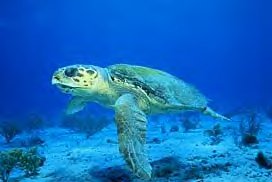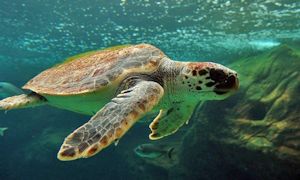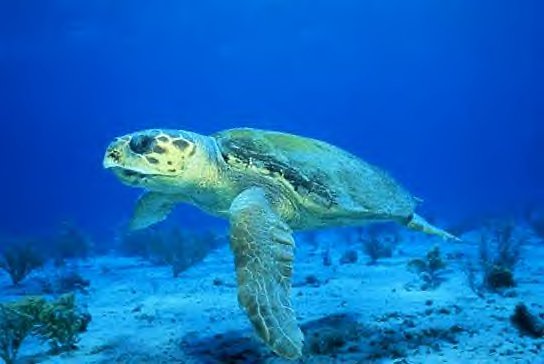Turtles
Description
31-48" (79-122 cm). Ocean-dwelling, with paddlelike limbs. Carapace elongated and heart-shaped, keeled (3 keels in young), reddish-brown; 5 or more costal scutes, 1st touching nuchal; 3 scutes on bridge. Plastron cream-yellow, with 2 ridges (lost with age). Two pairs of prefrontal scales between eyes. Male's tail extends well beyond shell.
Endangered Status
The Loggerhead is on the U.S. Endangered Species List. It is classified as endangered in Alabama, California, Connecticut, Delaware, Florida, Georgia, Louisiana, Massachusetts, Maryland, Mississippi, North Carolina, New Jersey, New York, Oregon, Rhode Island, South Carolina, Texas, and Virginia. Development of beaches and coastal islands has destroyed many of its nesting sites. Hatchlings, normally attracted to light reflected off the ocean, are sometimes confused by artificial highway lights and crawl toward them, and many are accidentally killed. In the past, many Loggerheads drowned in shrimp nets, but the introduction of turtle excluder devices, which allow them to escape from the nets, have reduced this threat significantly.
Habitat
Coastal bays, lagoons, estuaries, open seas.
Range
Warm waters of Atlantic and Pacific. In summer, ranges north to New England (occasionally Newfoundland), and to s. California.
Discussion
There are reports of Loggerheads taken in the past weighing 1,000 pounds (455 kg) or more. Such giants are probably gone, now that their numbers have been severely reduced. These sea turtles are omnivorous, their diet including sponges, molluscs, crustaceans, sea urchins, and marine plants.




